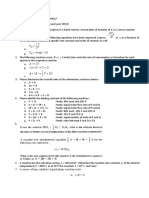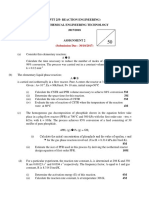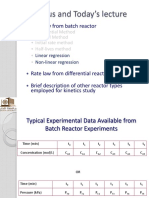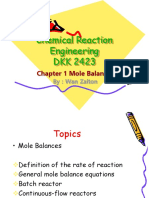0 ratings0% found this document useful (0 votes)
89 viewsTutorial 4
This document provides information and questions about gas and liquid phase reactions taking place in continuous stirred tank reactors (CSTR) and plug flow reactors (PFR). It asks the reader to determine reactor volumes needed for specific conversions, compares which reactor would achieve higher conversion for an irreversible reaction, and asks the reader to determine conversion for a reversible reaction given kinetic and equilibrium data.
Uploaded by
Aisyah ShaariCopyright
© © All Rights Reserved
Available Formats
Download as PDF, TXT or read online on Scribd
0 ratings0% found this document useful (0 votes)
89 viewsTutorial 4
This document provides information and questions about gas and liquid phase reactions taking place in continuous stirred tank reactors (CSTR) and plug flow reactors (PFR). It asks the reader to determine reactor volumes needed for specific conversions, compares which reactor would achieve higher conversion for an irreversible reaction, and asks the reader to determine conversion for a reversible reaction given kinetic and equilibrium data.
Uploaded by
Aisyah ShaariCopyright
© © All Rights Reserved
Available Formats
Download as PDF, TXT or read online on Scribd
You are on page 1/ 1
TUTORIAL 4- Topic 4
1. The elementary gas phase reaction takes place in a CSTR at constant
temperature 500K and constant pressure 16.4 atm. The feed is equal molar in
A and B. Determine the volume of CSTR to achieve 90% conversion. Given k
is 10 dm6/mol2.s and feed of A is 5 mol/s.
2. Repeat the question 1 for PFR.
3. The elementary, liquid-phase, irreversible reaction
is to be carried out in a flow reactor. Two reactors are available, an 800
dm3 PFR that can only be operated at 300 K and a 200 dm 3 CSTR that can be
operated at 350 K. The two feed streams to the reactor mix to form a single
fee d stream that is equal molar in A and B, with a total volumetric flowrate of
10 dm3/min. Which of the two reactors will give us the highest conversion?
Additional Information: at 300 K, k = 0.07 dm3/mol-min
E = 85000 J/mol-K
CA0B = CB0B = 2 mol/dm 3
vA0 = vB0 = 0.5*v0 = 5 dm3/min
4. For data given below, determine the volume required to achieve 50% and
80% conversion
a) CSTR
b) PFR
X 0 0.1 0.2 0.4 0.6 0.7 0.8
FAo/-ra 0.89 1.08 1.33 2.05 3.54 5.06 8.0
5. Write the rate law for this reversible reaction
A 2B
6. For reversible gas phase reaction
2A B
Determine the conversion achieved in PFR for 80% equilibrium conversion.
Given data as below:
Reaction Additional Information
CA0 = 0.2 mol/dm3 k = 2 dm3/mol-min
KC = 100 dm3/mol FA0 = 5 mol/min
You might also like
- Isothermal Reactor Design - With Audio - Part 1&2No ratings yetIsothermal Reactor Design - With Audio - Part 1&243 pages
- (P01, C01, C02, C2, C3) : Confidential EH/JUN 2014/CHE584/594No ratings yet(P01, C01, C02, C2, C3) : Confidential EH/JUN 2014/CHE584/59411 pages
- Assignment 1 CHE502/594 Reaction Engineering 1 Due Date: Monday (14 OF MAY 2018)No ratings yetAssignment 1 CHE502/594 Reaction Engineering 1 Due Date: Monday (14 OF MAY 2018)1 page
- CHME 314 Lecture 14 Collection and Analysis of Rate Data 2No ratings yetCHME 314 Lecture 14 Collection and Analysis of Rate Data 217 pages
- CEB2043 - Reaction Engineering I - Ch03 Rate Laws PDFNo ratings yetCEB2043 - Reaction Engineering I - Ch03 Rate Laws PDF25 pages
- For Student Test1 Version 3 SKKK1113 1112-1 PDFNo ratings yetFor Student Test1 Version 3 SKKK1113 1112-1 PDF3 pages
- Steady State Non-Isothermal Reactor DesignNo ratings yetSteady State Non-Isothermal Reactor Design34 pages
- CHE3044F, 2013: Reactor Design 1: TUTORIAL 3No ratings yetCHE3044F, 2013: Reactor Design 1: TUTORIAL 33 pages
- Topic 1: Siti Wahidah Binti Puasa PHONE NO: 03-55436327 011-32338927 Reference: Fogler 4 Edition, Levenspeil 3 EditionNo ratings yetTopic 1: Siti Wahidah Binti Puasa PHONE NO: 03-55436327 011-32338927 Reference: Fogler 4 Edition, Levenspeil 3 Edition35 pages
- Chemical Reaction Engineering (CHE 331A) Assignment-2 (2017-18-II)No ratings yetChemical Reaction Engineering (CHE 331A) Assignment-2 (2017-18-II)2 pages
- Lec 1 - Fundamental Concepts, Force VectorsNo ratings yetLec 1 - Fundamental Concepts, Force Vectors66 pages
- CHM 152 Final Exam Review 1 Spring 2012 NEW KEYNo ratings yetCHM 152 Final Exam Review 1 Spring 2012 NEW KEY4 pages
- CHFEN 3553 Chemical Reaction Engineering: April 28, 2003 1:00 PM - 3:00 PM Answer All QuestionsNo ratings yetCHFEN 3553 Chemical Reaction Engineering: April 28, 2003 1:00 PM - 3:00 PM Answer All Questions4 pages
- Exercise - Chemical Reaction EngineeringNo ratings yetExercise - Chemical Reaction Engineering4 pages



























































